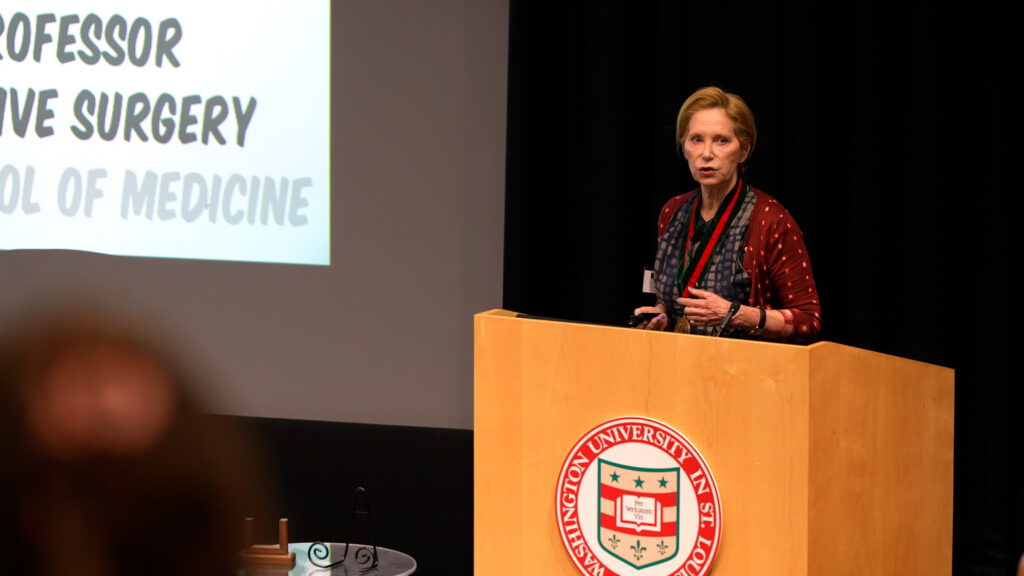On Thursday February 15, the Washington University School of Medicine formally installed Susan Mackinnon, MD as Minot Packer Fryer Professor of Plastic Surgery. This recognition cements her legacy among the pantheon of innovators in the field of plastic surgery at the medical school.
“Dr. Mackinnon has had an indelible and revolutionary impact on the practice of plastic surgery and improving the lives of people with nerve damage because of her relentless innovation,” says David H. Perlmutter, MD, executive vice chancellor for medical affairs and dean of Washington University School of Medicine in his introductory remarks.
The Minot Packer Fryer Professorship is named in honor of the leading expert in reconstructive and cosmetic surgery of his time. Fryer focused heavily on burns from atomic exposure. He taught at Washington University for 35 years and retired in 1981.
Mackinnon has been at the forefront of her field for decades, having published books, chapters and studies, and introducing innovative therapeutic treatment procedures in nerve transfer. She has also been a fixture in the Castle Connolly Top Doctors List since 2000 and has several other honors from the American Association of Plastic Surgeons (AAPS), including their highest honor, the AAPS Honorary Award, presented to her in April 2022 in San Diego at the association’s centennial meeting.
In 2001, Mackinnon established Plastic Surgery Research Laboratories (PSRL) at Washington University School of Medicine. Mackinnon performed the first ever human nerve transplant in 1988 using nerves from a cadaver to restore movement and feeling to a patient’s injured leg. In the years following, Mackinnon and the team of investigators have pioneered a new era of nerve surgery, developing advanced techniques and a greater understanding of nerve injury and regeneration. The PSRL has been continuously funded by NIH grants since 1993.
Minot P. (Tad) Fryer Jr. expressed his late father’s respect for Mackinnon’s expertise and achievements.
“My father would be pleased to be remembered for his contribution to plastic surgery,” Fryer Jr. says. “Not only would he be pleased, but delighted that Dr. Mackinnon is the inaugural holder of Minot Packer Fryer Chair of Plastic Surgery. I know that because he told me on more than one occasion how much he admired and respected Dr. Mackinnon.”
Paradigm Shift in Nerve Surgery
In her address, Mackinnon recognized the state of nerve surgery and the trajectory that brought her to nerve transfer. “When I started the results for reconstructed nerves was poor and usually painful for patients even after a dozen surgeries,” she says. “Now the outcomes can be fantastic and horrible neuropathic pain that people have had for decades can be fixed almost in an instant.”
Mackinnon’s research has brought her to conceive of a nerve transfer procedure, whereas her predecessors maintained that nerve regeneration was the end-goal, despite obvious limitations, due to the extremely slow rate of regeneration of nerve tissue.
Mackinnon credits her mentors for providing the substance for her imagination to later conceive of the procedure which has in part defined her career as a plastic surgeon. “This is not a new concept. I didn’t arrive to this solution in a vacuum,” Mackinnon says, crediting her mentors for providing the substance for her imagination to later conceive of the procedure which has in part defined her career as a plastic surgeon.
“There’s redundancies everywhere,” says Mackinnon. “You can borrow a little bit of nerve from the pectoral muscle and slip it into the bicep. Robbing Peter to pay Paul is reconstructive surgery.”
Beating the Odds
Mackinnon recognized Dave Logan’s concept of tribal leadership. “We’re all great and we are passionate about it. Our lab is full of incredible people who share one priority—and that’s nerve.” She emphasized the long process of arriving at innovation for herself and the team, and the value of serendipity in innovation. “It’s slow,” she said. “But it’s sure, and there’s sure to be failure, and for failure to be a gift, you need to go in a different direction. Don’t stay stuck. Study the problem and figure out what went wrong.”
Mackinnon also emphasized the importance of disseminating innovation.
“A new paradigm does not take hold instantly. It typically takes around thirty years for new ideas to take hold. But if the idea doesn’t catch on, it’s as if it didn’t happen,” she referred to an article by E.A. Balas that states that it takes seventeen years for 14% of great medical ideas to reach 15% of the people who would benefit. “I’m thankful for the encouragement from colleagues who recommended disseminating new ideas faster than the diffusion curve,” she says.
Starting in 2016 Mackinnon created a series of videos on operations and several related topics for implementing these procedures. “Thanks to our efforts in dissemination, we met the threshold for adoption,” says Mackinnon. “All of the work that we’ve done now has been adopted. It met that fifteen to twenty percent threshold and it’s out there.”
